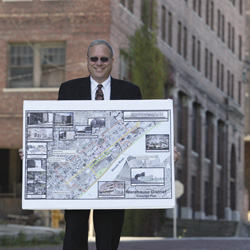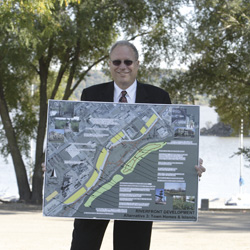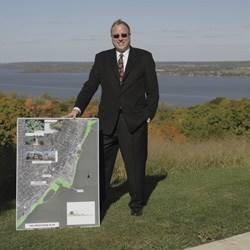
Craig Hullinger has served as the Director of Economic Development for the City of Peoria since 2005. A member of the American Institute of Certified Planners, he is a strong advocate for redevelopment of the city’s inner core. He and his wife, Beth Ruyle Hullinger, have two children and live on High Street in Peoria.
Tell about your background, education, family, etc.
I was born in South Dakota and raised in South Chicago. After high school, I did one year of volunteer social work in Norfolk, Virginia, in the Prince of Peace Corps before joining the Marine Corps. I served 4.4 years on active duty, including 18 months in Vietnam. I then earned a BA and MA, and began my career as a city planner. I stayed in the Marine Corps Reserve, retiring as a colonel.
Explain the process by which you became the City of Peoria’s economic development director. How did your previous experience prepare you for this position?
I previously worked as a city planning consultant and city manager in the southern portion of the Chicago metropolitan area. In the late 1970s and early ‘80s, the southern suburbs of Chicago and Will County (Joliet) went through very tough economic times, similar to what happened in Peoria with the decline of our manufacturing base. Most of the city planners and managers learned economic development on the job. I have always enjoyed the positive part of economic development and city planning, and try to follow the motto of “Leave your city better then you found it.”
Among other positions that I have held were: land use director and planning director for Will County; village administrator of Minooka, Olympia Fields and Park Forest South; and assistant manager of the Village of Tinley Park. As noted, all communities are in the southern suburbs of the Chicago area. I believe elected officials from all of those communities believe the community was better as the result of my efforts.
I spent a total of 32 years in the Marine Corps, with the first 4.4 years on active duty, and the remaining time in the Marine Corps Reserve. I advanced from an 18-year-old private to 1st lieutenant while on active duty, and served 18 months in Vietnam. I was promoted to colonel in the Reserves. The Marine Corps taught me a lot of things about staying positive and making the extra effort to accomplish the mission.
Explain how you identify issues of concern to existing businesses and assist with their resolution.
Retaining the businesses that you have is the first rule of economic development. The City has developed a system of meeting with businesses and asking them about concerns they have regarding city services or any other issue. If we can resolve problems, we do so. And, of course, the City Council is responsive to the needs of businesses. They often ask us to help resolve problems.
Asking what our business leaders and citizens think is perhaps the most important aspect of this effort. People have a pretty good idea of what should happen to improve the city. Listening to them and then trying to take the actions that will correct problems is important.
How do you identify and pursue businesses for potential relocation to Peoria?
We work closely with the Heartland Partnership, the Economic Development Council, and the State of Illinois to identify and pursue potential businesses for relocation in Peoria. A large number of companies and consultants contact us for available land or sites.
We spend a lot of time trying to get developers from outside the region to look at urban redevelopment opportunities in our region. The City developed the Heart of Peoria plan and the Renaissance Park plan calling for new urban development in the city.
We also have an aggressive marketing program. We attend conferences where developers are looking for sites and distribute marketing materials. Finally, we are part of the City’s website, as well as maintaining a number of blogs for the department.
What is the most important thing an economic development director can do to attract and retain business?
The City and region have worked hard to improve our reputation as a place where people can get answers quickly. As we know from recent newspaper articles, the perception of Peoria as a place to do business has been steadily improving.
The Innovation Center is a good case in point. This collaboration of Bradley University, Caterpillar, the Heartland Partnership and the City of Peoria has resulted in a great institution that incubates high-tech startups. They help young businesses grow and thrive. The reputation that all parties will work together to make it happen is getting out there.
The City has made a strong commitment to revitalizing the Heart of Peoria. The City developed the plan and the form-based code and adopted Enterprise Zone and TIF incentives to help attract the middle class back to the city. We have created some great incentives for developers to build new housing near downtown and to rehab older structures to provide new mixed-use development.
Explain the idea behind the proposed Heart of Peoria Development Corporation. How might this help kickstart redevelopment of the area around downtown?
The citizens of Peoria want to improve their great city. The City has responded by creating an Enterprise Zone and Tax Increment Financing districts that provide substantial incentives for redevelopment of the Heart of Peoria.
The downtown area is the home for many dynamic businesses, with nearly 20,000 employees working downtown. The riverfront is beautiful. However, the City needs more homes near downtown and more retail to revitalize the area and keep some of those workers in the downtown.
To achieve that, we need more developers and entrepreneurs. The City has many quality developers, but more investment is needed.
As a new startup, the Heart of Peoria Development Corporation could raise the funds necessary to kickstart the redevelopment of the area around downtown. The company would be for-profit and would raise capital and hire the CEO who would lead the redevelopment. Alternately, no staff would be hired—the corporation would simply partner with developers. Sources of funds would include private investment and pension funds. The company would focus on redevelopment in and near the downtown, including, but not limited to, the Warehouse District, the Riverfront, Renaissance Park, Eagle View and other redevelopment areas. They would be partners with the City.
The Board must consist of respected civic leaders of impeccable reputation. The Board should have some real estate redevelopment experience, but the primary need is for business leaders who want to make money for their stockholders and see the city improve.
Development corporations have been used successfully in other cities, and I believe it could be successful here. You can find more information on this idea at peoriadevelopmentcorporation.blogspot.com. 
What is the current status of the Hospitality Improvement Zone? River Trail Drive? Green Edge Plan? Eagle View District? Warehouse District?
These projects are moving along well. As part of our effort to make government open, fair and transparent, we maintain a series of blogs on all of these items. You can go to the master blog, peoriaed.blogspot.com and find current information on most of these projects.
There have been 10 redevelopments in Peoria TIFs over the past three years, and there are a number that should soon start. Of course, the state of the economy may slow down some of these projects.
Of all of the development ideas on the table for the Peoria area, which one excites you the most?
The Green Edge and River Trail Drive plan. This will transform the Riverfront, creating a two-mile-long riverfront park and lake, paid for by new mixed-use development. The plan is similar to the Grand View Drive plan and the Chicago Lakefront plan, with beautiful parks along the riverfront and a drive to enjoy the view. I am confident that we will find a quality developer to build the first three quarters of a mile soon. The rest of the development will happen slowly over time.
If you could only implement a single project next year, what would it be?
I would jump off the I-74 bridge if we could only implement a single project. In economic development, not all ideas and programs will succeed. Therefore, you have to have a number of balls in the air, with some dropping out while the others are implemented. However, sometimes my staff wishes I would quit throwing so many balls into the air.
Some critics believe that the Tax Increment Financing (TIF) mechanism has been extended to areas not in need of it. What are your thoughts on that?
If you look at the maps on peoriatif.blogspot.com, you can see that all of the TIFs are in the Heart of Peoria. They are all in neighborhoods that have seen major challenges.
The Southtown Tax Increment Financing District is one of the oldest TIFs in the State of Illinois. It was part of a massive urban renewal effort in the area just south of downtown. The redevelopment was controversial and took many years, but it did result in substantial new development for Peoria, creating a tax base and jobs.
The percentages below illustrate the growth in fair market value, comparing District 150, the City of Peoria and the Southtown TIF from 1978, when the TIF was created, until 2006, the latest assessment dates.
District 150 87%
City of Peoria 146%
Southtown TIF 477%
In addition, there are two recent developments underway in Southtown—the new Long-Term Acute Health Care Center and the Main Street Medical Clinic. These two large developments will add more value and jobs to the TIF.
The TIF will end in 2013. From that date forward, taxes paid on the new development will go to local taxing bodies. The TIF certainly increased the value of the TIF area. Growth in District 150 is lower than in the city because substantial amounts of new development that are part of the city are north of the District 150 boundary. This points out the need for District 150 to support redevelopment of older neighborhoods—and the most effective method to incent redevelopment in older neighborhoods is with TIF.
This TIF did create some housing with children. The City used TIF funds to help acquire land and provide $2.5 million for the Valeska Hinton School.
The new medical clinic on Main Street is a great success. Without the TIF assistance to help build the parking deck, it would have gone to the north side of the city. District 150 would have lost that tax base, and the central city, the jobs.
What is the biggest challenge you face in trying to bring an idea to fruition?
The biggest challenge is finding developers to take the chance on developing older parts of the city. It is always safer and easier to go to green grass sites in higher income areas. The risk is much greater in older areas, since you may have unknown environmental risks, and the market is less established.
That is one of the reasons we need the Peoria Development Corporation. So, heavy hitters of Peoria, listen up. We need you to finance the redevelopment of the Heart of Peoria.
You’ve started more blogs than anyone I know. Explain how you use technology to promote the economic agenda in Peoria.
We have a number of nice brochures and maps that we use with developers and citizens, but distribution is slow and expensive. The blog is free and easy. So we put it on the blog.
I will frequently talk to a developer, and direct him to an appropriate blog. He can look at a map or development proposal as we talk.
I am constantly surprised at the number of people who find out about an opportunity from one of the blogs. We only started doing this in January, but it continues to build.
Of course, it is also a good way for a bureaucrat to get into trouble. We are putting a lot of information out there. Some of it can be controversial. When I first broke into city planning, my boss told me that we were like the “point man,” the person who is out front leading the charge. This is, of course, a good place to get shot.
I also have a saying: “When you take this job, you are issued a bagful of marbles. Every time a mistake is made, whether it is your fault or not, one marble is taken away. No new marbles are ever added for any reason. After a while, you lose your marbles.”
 You have travelled all over the world—what has been your most memorable adventure overseas?
You have travelled all over the world—what has been your most memorable adventure overseas?
Vietnam. It was a nice place to visit, but I would not want to live there. I first arrived there on Christmas Eve, 1969. My wife and I returned in 1999. It is still a beautiful country. Now that the government is finally loosening up, it is making economic progress. Very nice and hard-working people.
I have been around the world twice. The first time was while I was on leave from Vietnam, where I was serving as a first lieutenant in the Marine Corps near Danang. I extended my tour for six months. As a result, I received an airplane ticket around the world. I visited Japan, the U.S., Rome, Athens, Israel, India, Bangkok and Vietnam.
My wife and I usually travel overseas once a year. Several years ago, we took a sabbatical for six months and went back around the world. I would caution anyone wanting to travel with us, however. With our city management and planning backgrounds, we may be more interested in the local sewer plant than the nearest museum. The blog at chullinger.blogspot.com has some photos and stories about that trip.
Anything else you would like to add?
I should note that all of what is happening is the result of the support of the mayor and City Council, with direction from the city manager. They make economic development and the redevelopment of the city a priority, and this sets the scene for us to work with them on all of the above programs. They challenge the entire City staff to maintain what makes us a great city and develops us into the best city. And of course our great institutions and companies who invest in our city are vital.
You can find out more than you ever wanted to know about me and the economic development program on our blogs at peoriaed.blogspot.com. Peoria is a great city, and we are helping to make it even better. iBi

